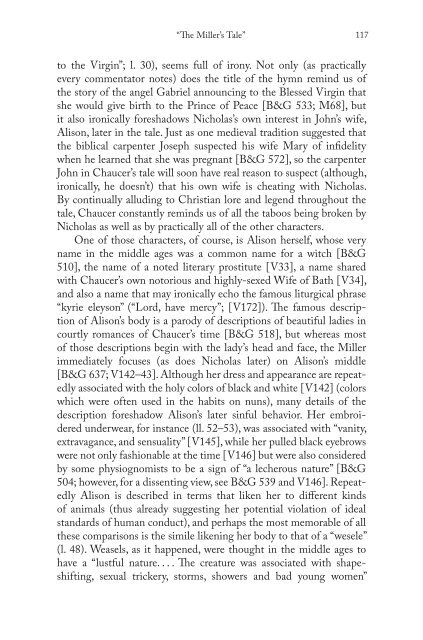Bloom's Literary Themes - ymerleksi - home
Bloom's Literary Themes - ymerleksi - home
Bloom's Literary Themes - ymerleksi - home
Create successful ePaper yourself
Turn your PDF publications into a flip-book with our unique Google optimized e-Paper software.
“The Miller’s Tale” 117<br />
to the Virgin”; l. 30), seems full of irony. Not only (as practically<br />
every commentator notes) does the title of the hymn remind us of<br />
the story of the angel Gabriel announcing to the Blessed Virgin that<br />
she would give birth to the Prince of Peace [B&G 533; M68], but<br />
it also ironically foreshadows Nicholas’s own interest in John’s wife,<br />
Alison, later in the tale. Just as one medieval tradition suggested that<br />
the biblical carpenter Joseph suspected his wife Mary of infidelity<br />
when he learned that she was pregnant [B&G 572], so the carpenter<br />
John in Chaucer’s tale will soon have real reason to suspect (although,<br />
ironically, he doesn’t) that his own wife is cheating with Nicholas.<br />
By continually alluding to Christian lore and legend throughout the<br />
tale, Chaucer constantly reminds us of all the taboos being broken by<br />
Nicholas as well as by practically all of the other characters.<br />
One of those characters, of course, is Alison herself, whose very<br />
name in the middle ages was a common name for a witch [B&G<br />
510], the name of a noted literary prostitute [V33], a name shared<br />
with Chaucer’s own notorious and highly-sexed Wife of Bath [V34],<br />
and also a name that may ironically echo the famous liturgical phrase<br />
“kyrie eleyson” (“Lord, have mercy”; [V172]). The famous description<br />
of Alison’s body is a parody of descriptions of beautiful ladies in<br />
courtly romances of Chaucer’s time [B&G 518], but whereas most<br />
of those descriptions begin with the lady’s head and face, the Miller<br />
immediately focuses (as does Nicholas later) on Alison’s middle<br />
[B&G 637; V142–43]. Although her dress and appearance are repeatedly<br />
associated with the holy colors of black and white [V142] (colors<br />
which were often used in the habits on nuns), many details of the<br />
description foreshadow Alison’s later sinful behavior. Her embroidered<br />
underwear, for instance (ll. 52–53), was associated with “vanity,<br />
extravagance, and sensuality” [V145], while her pulled black eyebrows<br />
were not only fashionable at the time [V146] but were also considered<br />
by some physiognomists to be a sign of “a lecherous nature” [B&G<br />
504; however, for a dissenting view, see B&G 539 and V146]. Repeatedly<br />
Alison is described in terms that liken her to different kinds<br />
of animals (thus already suggesting her potential violation of ideal<br />
standards of human conduct), and perhaps the most memorable of all<br />
these comparisons is the simile likening her body to that of a “wesele”<br />
(l. 48). Weasels, as it happened, were thought in the middle ages to<br />
have a “lustful nature. . . . The creature was associated with shapeshifting,<br />
sexual trickery, storms, showers and bad young women”
















